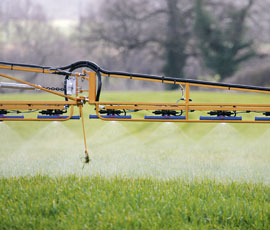Higher spend pays off in tough disease year

Top-notch wheat yields and gross margins are convincing Lincolnshire farm manager Keith Challen of the benefits of switching to new SDHI fungicides for his disease control.
Mr Challen raised his fungicide spend to reflect the high disease year in 2012, but this strategy came up trumps with winter wheat yields of 11.64t/ha and gross margins of £1,928/ha.
He recognised early in the season that he was sitting on a disease ‘timebomb’ and needed robust disease control so was prepared to see his variable costs rise in excess of £600/ha.
“I spent an additional £150/ha on crop inputs in 2012 compared to 2011,” says the Farmers Weekly Focus contributor.
Mr Challen adds that 2012 wasn’t the right season to get hung up about fungicide costs.
“The crops had plenty of potential and it was clear that grain prices were going to remain high. Once we could see how much septoria pressure was around, we made the decision to up the rate,” he says.
Mr Challen, who manages 912ha of wheat and oilseed rape at Belvoir Fruit Farms, near Grantham, also ran a commercial trial for BASF, comparing the three different SDHI products on the market.
All of them – Adexar, Seguris and Aviator – were applied at the T2 flag-leaf timing on the feed wheat variety KWS Santiago, across large 2.2ha plots.
“Having a practical trial on the farm was useful. The new chemistry did very well in a horrendous season, but we did see some differences between the products. And on that basis, we used Adexar as our standard T2 treatment across the whole farm,” he says.
His initial decision to use 1.5l/ha of Adexar was revised upwards to 2l/ha as the T2 timing approached. “It put the cost up by £17/ha,” he notes.
“But it was easy to justify the extra spend – we were growing Oakley and KWS Santiago, neither of which has good septoria resistance, and our very heavy soils mean that spray windows are small, especially when the weather turns against us, as it did last year.”
Septoria is the main disease driver on his farm and he aims to prevent rather than cure, as there is always the chance he will not be able to react quickly enough if the disease takes hold.
Mr Challen plans to use a similar fungicide programme in 2013, but for very different reasons.
“The conditions experienced this season mean that crops will be difficult to manage. The plants are smaller and poorly rooted, but disease is present, so they will need help,” he says.
He intends to use an early T0 spray based on kresoxim-methyl + fenpropimorph + epoxiconazole, followed by a boscalid-based April T1 spray, with additional triazole.
“Adexar will feature again at T2, but the decision on rate will be taken nearer the time.”
The SDHIs have replaced his reliance on triazoles. “They arrived just in time. Triazoles struggled to give the disease control required last year.”
BASF agronomy manager Ruth Stanley believes the best place for Adexar in 2013 spray programmes is at T2, in most situations.
The only exception to this is where the T1 spray is late and septoria is present. “Switch to Adexar at T1 if septoria infection has already occurred,” she says.
Otherwise, the use of 1l/ha of Tracker with chlorothalonil is her preferred option at T1, with Adexar coming in at T2, either with or without chlorothalonil.
“The Adexar rate should be at least 1.25l/ha,” she stresses. “And chlorothalonil can be used with it, which is important for resistance management and to protect the life of the new chemistry.”
A good septoria strategy will benefit a variety such as KWS Santiago, says John Miles of plant breeder KWS.
“It has a 5 rating for septoria, so it will respond well to fungicides,” he adds.
In a KWS trial conducted last year, the use of Adexar at T2 instead of an Ignite/Comet mix gave an additional yield of 1.28t/ha, which is worth £250, he adds.
Plant Growth Regulators also have a role to play with the variety, continues Mr Miles. “It has tremendous yield potential and it produces a big canopy, but it’s not as stiff as Oakley,” he warns.
On very fertile sites, he recommends a split application of chlormequat plus 0.1l/ha Moddus. “It may also be worth including 0.75l/ha of Terpal with the second split.”
SDHI Trial Plot Costs* | |
Seguris | 1l/ha £44/ha |
Aviator | £38.50/ha |
Adexar | £59.20/ha |
Adexar | £78.94/ha |
*2012 fungicide prices | |
Belvoir Fruit Farms – winter wheat results 2012 | |
Yield | 11.64t/ha |
Price | £220/t |
Variable costs | £632.80/ha |
Gross margin | £1928.00/ha |
Read more articles on fungicides
Four new fungicides to tackle oilseed rape disease
Disease control is a priority with grain prices high
Early fungicide spray can keep barley diseases at bay

